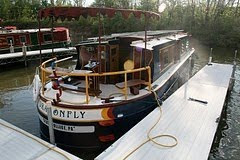 |
| Making a new friend at Cape Canveral |
We arrived in New Smyrna Beach, Florida, Friday noonish, and scored a rental car. The bubbly rental car girl said, "One place you should visit is Cape Canaveral National Seashore. It's just like the desert in AFRICA!"
 |
| Time machine: Us in 30 years |
On the way we spotted red-winged blackbirds in a marsh, singing a rusty conk-a-ree! In New York and Pennsylvania, you never hear that sound till late March, when spring is bustin' in.
The sound brought back a vivid memory, of traveling to Costa Rica in winter, and seeing RWBBs in the marshes there.
Sure, everyone knows--intellectually--that "Some birds fly south for the winter." But the first time you actually SEE your old familiar summer friends, IN winter, ON their winter vacation, it gives you this funny feeling of revelation: "Hey, bird migration isn't a just-so story. It's real!"
 |
| When you least expect it: wild orange |
Walking at dusk along a trail through an oak hammock, where live oak trees with trunks thick as barrels sent crooked branches sideways overhead to make a shady tunnel, we saw a little spot of light . . . something glowing, bright orange.
It was, literally an orange. Citrus fruit, on a tree, in the middle of what we perceived to be wild forest.
Turns out, around the turn of the 20th century, the spot was a homestead, with prosperous citrus groves. After a big freeze, the settlement was abandoned. Forest grew back, yet a few orange trees survived.
The story goes back farther than that. Spanish explorers first brought the rootstock for orange trees here in the 1600s. These sour oranges were hardy and persisted. The later settlers grafted new shoots onto the roots of the original trees.
 |
| The view at Castle Windy |
 |
| A whole heap of oyster shells |
Saturday we returned to the park, to hike a trail to a spot called Castle Windy. The "castle" is a heap of oyster shells big and tall as a house, at the edge of Mosquito Lagoon. It's a "midden," or garbage heap, left by Timuacan Indians.
Looking out over the clear, placid waters to the ospreys hunting over the mangrove islands, we couldn't think of a nicer place to sit and shuck and slurp oysters--though we felt sad for the aboriginals, having no Tabasco or horseradish.
 |
| Mmmm, mmmm, good! |
Looking up, we saw bare branches sprouting tiny, spiky flowerets, each no bigger than a fingernail. And flying from flower to flower, the noisemakers: dozens of honeybees, diligently collecting nectar and pollen.
Flowers and honeybees in January! Must be spring.





No comments:
Post a Comment